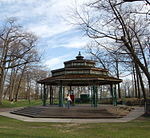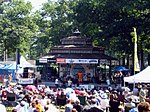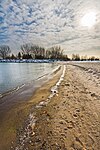Beach Hebrew Institute
The Beach Hebrew Institute (also known as Beth Jacob Congregation or in Hebrew as Beit Knesset Beit Ya'akov) is a synagogue in The Beaches neighbourhood of Toronto, Ontario, Canada. Founded in 1919 as an Orthodox Jewish congregation, the members purchased their current building—a former church—in 1920, and renovated it in 1926. Following World War II the congregation declined. The members considered selling the building in the 1970s, but a campaign to save it led to its receiving much needed repairs, and the 1982 designation of the building as a site of historical importance by the City of Toronto. An influx of younger, more liberal families, led to the congregation becoming an unaffiliated egalitarian Conservative synagogue.
Excerpt from the Wikipedia article Beach Hebrew Institute (License: CC BY-SA 3.0, Authors).Beach Hebrew Institute
Kenilworth Avenue, Toronto
Geographical coordinates (GPS) Address Phone number Website External links Nearby Places Show on map
Geographical coordinates (GPS)
| Latitude | Longitude |
|---|---|
| N 43.669323 ° | E -79.301592 ° |
Address
Beach Hebrew Institute
Kenilworth Avenue 109
M4L 1H6 Toronto
Ontario, Canada
Open on Google Maps









